Everyday Mathematics 1st Grade Answer Key Unit 2 Introducing Addition
Everyday Mathematics Grade 1 Home Link 2.1 Answers
Introducing Addition Strategies
Family Note
In today’s lesson, your child learned an important property of addition: The order in which the numbers are added does not matter. The sum, or answer, is always the same. We call this the turn-around rule.
Question 1.
Solve.
Jai has 3 shells.
His sister has 5 shells.
How many shells do they have in all?
______ shells
Answer:
Total number of shells they have in all = 8 or Eight.
Explanation:
Number of shells Jai has = Three or 3.
Number of shells Jai ‘s sister has = Five or 5.
Total number of shells they have in all = Number of shells Jai has + Number of shells Jai ‘s sister has
= 3 + 5
= 8 or Eight.
Ellen found 5 rocks.
Her friend found 3 rocks.
How many rocks do they have in all?
______ rocks
Answer:
Total number of rocks they have in all = 8 or Eight.
Explanation:
Number of rocks Ellen found = 5 or Five.
Number of rocks Ellen’s friend found = 3 or Three.
Total number of rocks they have in all = Number of rocks Ellen found + Number of rocks Ellen’s friend found
= 5 + 3
= 8 or Eight.
Question 2.
Explain to someone at home how these number stories are alike and how they are different.
Answer:
They are alike because the sum of numbers both are the same. They are different because they are the sum of two different items.
Question 3.
Practice
Count up by 5s.
20, 25, ______, ______, ______, 45, ______
Answer:
20 , 25 , __30__ , __35__ , __40__ , 45 , __50__.
Explanation:
Count up by 5s.
The missing numbers are 30 , 35 , 40 , 50.
Everyday Math Grade 1 Home Link 2.2 Answer Key
Two-Fisted Penny Addition
Family Note
Today your child learned about pairs of numbers that add to 10. Knowing these pairs is useful for later work with addition and subtraction facts. Help your child find pairs of numbers that add to 10 by doing Two-Fisted Penny Addition together.
Question 1.
Do Two-Fisted Penny Addition with someone at home:
- Place 10 pennies on the table. Grab some pennies with one hand. Pick up the rest with the other hand.
- Place each handful of pennies in its own pile.
- Use the table below to write how many pennies are in each pile.
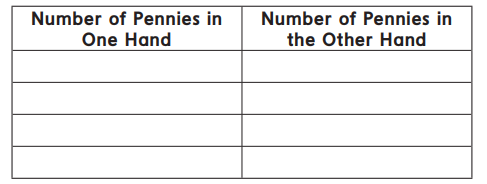
Answer:
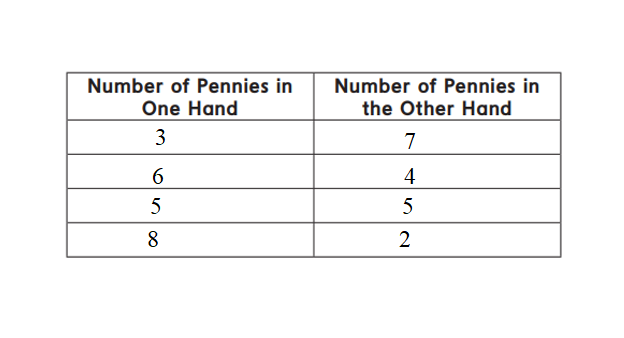
Explanation:
Number of pennies in one hand + Number of pennies in other hand = Total number of pennies count of 10.
3 + 7 =10.
6 + 4 = 10.
5 + 5 = 10.
8 + 2 = 10.
Practice
Question 2.
Shane has 4 model boats. He buys 2 more boats. How many boats does Shane have now?
_________ boats
Answer:
Total number of boats Shane has now = 6 or Six.
Explanation:
Number of boats Shane has = 4
Number of boats Shane buys = 2
Total number of boats Shane has now = Number of boats Shane has + Number of boats Shane buys
= 4 + 2
= 6 or Six.
Everyday Mathematics Grade 1 Home Link 2.3 Answers
Pairs of Numbers That Add to 10
Family Note
In this lesson, children continue finding pairs of numbers that add to 10 by playing a game called Penny Plate. Have your child explain how to play the game and play it together at home. Once your child has mastered pairs of numbers that add to 10, play the game with larger numbers of pennies.
Question 1.
Manny has 10 balloons.
Some of the balloons are blue.
Some of the balloons are yellow.
Draw a picture to show how many of each color balloons Manny might have.
Answer:
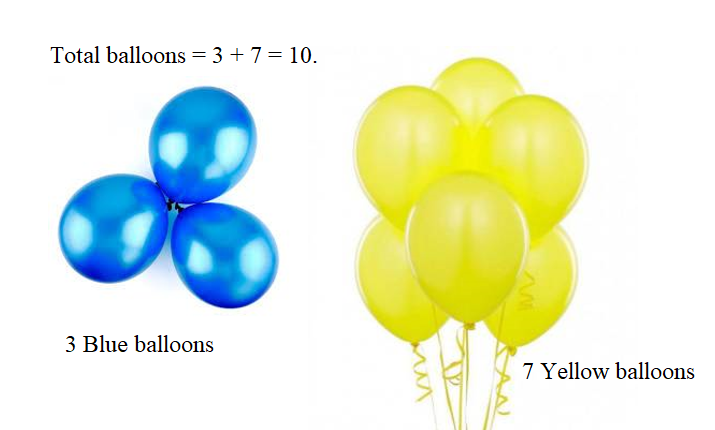
Explanation:
Number of Blue balloons Manny might has = 3 or Three
Number of Yellow balloons Manny might has = 7 or Seven
Total Number of balloons Manny has = Number of Blue balloons Manny might has + Number of Yellow balloons Manny might has
= 3 + 7 = 10.
Practice
Question 2.
Start at 5. Count up 5. Where do you land?

Answer:
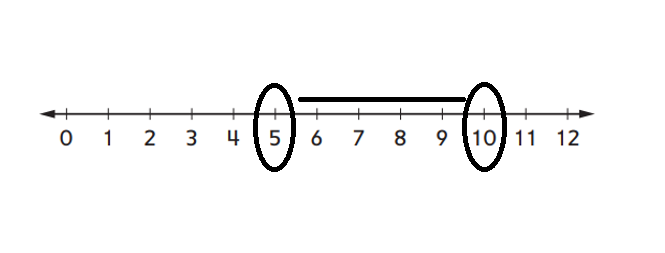
Explanation:
Starting at 5. Counting up 5.
5 , 10.
Everyday Math Grade 1 Home Link 2.4 Answer Key
Ten Frames
Family Note
One way children explore pairs of numbers that add to 10 is by using ten frames. In one of today’s Explorations, your child used a ten frame to help find all the possible combinations of 10 red and green apples. Also in today’s lesson, children played a subtraction game and collected data about objects in the room.
Three ten frames are shown below. Have your child explain to you why these are called ten frames. Throughout the year, children will work with ten frames to help them identify, compare, break apart, and add numbers.
Question 1.
How many dots are in the ten frame?_________

How many blank spaces are in the ten frame? _________
Answer:
Number of blank spaces in the ten frame = 6 or Six.
Explanation:
Number of dots in the ten frame = Four or 4.
Total number of blank spaces in the frame given = ten or 10.
Number of blank spaces in the ten frame =Total number of blank spaces in the frame given – Number of dots in the ten frame
= 10 – 4
= 6 or Six.
Question 2.
How many dots are in the ten frame? _________

How many blank spaces are in the ten frame? _________
Answer:
Number of blank spaces in the ten frame = Two or 2.
Explanation:
Number of dots in the ten frame = Eight or 8.
Total number of blank spaces in the frame given = ten or 10.
Number of blank spaces in the ten frame =Total number of blank spaces in the frame given – Number of dots in the ten frame
= 10 – 8
= 2 or Two.
Question 3.
How many dots are in the ten frame? ________

How many blank spaces are in the ten frame? ________
Answer:
Number of blank spaces in the ten frame = 5 or Five.
Explanation:
Number of dots in the ten frame =5 or Five.
Total number of blank spaces in the frame given = ten or 10.
Number of blank spaces in the ten frame =Total number of blank spaces in the frame given – Number of dots in the ten frame
= 10 – 5
= 5 or Five.
Practice
Question 4.
How many chairs are in your house?
_________ chairs
Answer:
Total number of Chairs in my house = Five or 5.
Explanation:
Number of Chairs in Hall room in my house = Three or 3.
Number of Chairs in Dinning room in my house = 2 or Two.
Total number of Chairs in my house = Number of Chairs in Hall room in my house + Number of Chairs in Dinning room in my house
= 3 + 2
= 5 or Five.
Everyday Mathematics Grade 1 Home Link 2.5 Answers
Finding All of the Ways to Make 10
Family Note
Today your child was asked to find all possible combinations of 10 apples if some are red and some are green. Children then explained how they knew they had found all the combinations. This task extended children’s work with finding pairs of numbers that add to 10 and encouraged them to use patterns (such as putting the combinations in a logical order) to solve problems.
Question 1.
There are 10 toys in a toy box. Some toys are blocks, and some toys are dolls. Draw a picture of the toys in the toy box.
Answer:

Explanation:
Number of Doll toys in the toy box = 4 or Four.
Number of Water Blocks toys in the toy box = 6 or Six.
Total number of toys in the toy box = Number of Doll toys in the toy box + Number of Water Blocks toys in the toy box
= 4 + 6
= 10.
Question 2.
Draw a different picture of toys in the toy box.
Answer:
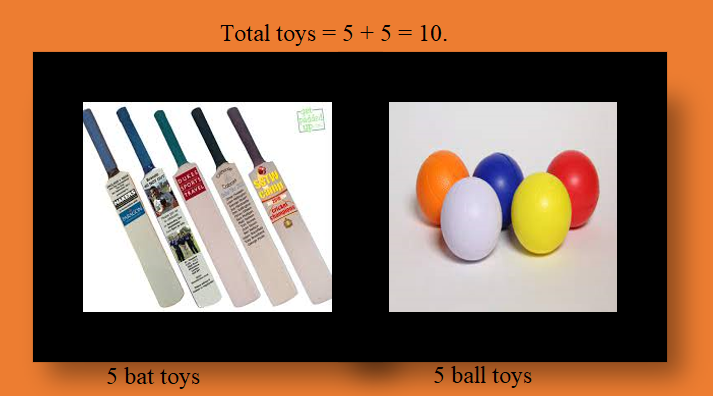
Explanation:
Number of bat toys in the toy box = 4 or Four.
Number of ball toys in the toy box = 6 or Six.
Total number of toys in the toy box = Number of bat toys in the toy box + Number of ball toys in the toy box
= 5 + 5
= 10.
Practice
Question 3.
There are 2 bananas and 3 oranges in a bowl. How many pieces of fruit are there in all?
_________ pieces of fruit
Answer:
Total number of fruits in all = 5 or Five.
Explanation:
Number of bananas in a bowl = 2 or Two.
Number of oranges in a bowl = 3 or Three.
Total number of fruits in all = Number of bananas in a bowl + Number of oranges in a bowl
= 2 + 3
= 5 or Five.
Everyday Math Grade 1 Home Link 2.6 Answer Key
More Uses of Ten Frames
Family Note
You have already seen your child use ten frames to identify pairs of numbers that add to 10. Today, children were shown ten frames on Quick Look Cards for a few seconds and asked to identify the number represented. This activity helps children develop mental images for numbers, which helps them become fluent with addition and subtraction.
Question 1.
Show the number 6 in three different ways.

Answer:

Explanation:
First ten frame:
Number of Yellow dots = 3 or Three.
Number of Black dots = 3 or Three.
Total number of dots = Number of Yellow dots + Number of Black dots
= 3 + 3
= 6 or Six.
Second ten frame:
Number of Blue dots = 5 or Five.
Number of Grey dots = 1 or One.
Total number of dots = Number of Blue dots + Number of Grey dots
= 5 + 1
= 6 or Six.
Third ten frame:
Number of Orange dots = 4 or Four.
Number of Green dots = 2 or Two.
Total number of dots = Number of Orange dots + Number of Green dots
= 4 + 2
= 6 or Six.
Question 2.
Show the number 5 in three different ways.
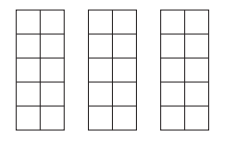
Answer:

Explanation:
First ten frame:
Number of Pink dots = 0 or Zero.
Number of Black dots = 5 or Five.
Total number of dots = Number of Pink dots + Number of Black dots
= 0 + 5
= 5 or Five.
Second ten frame:
Number of Blue dots = 4 or Four.
Number of Green dots = 1 or One.
Total number of dots = Number of Blue dots + Number of Green dots
= 4 + 1
= 5 or Five.
Third ten frame:
Number of Yellow dots = 3 or Three.
Number of Red dots = 2 or Two.
Total number of dots = Number of Yellow dots + Number of Red dots
= 3 + 2
= 5 or Five.
Practice
Question 3.
Count by 5s.
35, ______, ______, 50, ______, 60, ______, 70
Answer:
35, __40____, ___45___, 50, __55____, 60, __65____, 70.
Explanation:
Counting by 5s.
Missing numbers are:
40 , 45 , 55 , 65.
Everyday Mathematics Grade 1 Home Link 2.7 Answers
Labeling Counts
Family Note
In everyday life, numbers are used in contexts. You seldom encounter just the number 6. You see 6 cans of juice, 6 dollars, a length of 6 feet, and so on. In class your child will be asked to put numbers in context, too. The unit box is a reminder to children that they should consider the contexts of the numbers they are using.
Question 1.
Draw a picture of a group of objects. Fill in the unit box. Tell how many objects you counted.
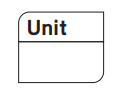
Answer:
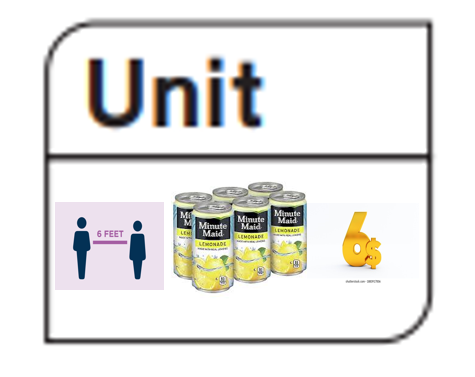
Explanation:
Number of objects seen in the Unit box = 6 cans of juice, 6 dollars, a length of 6 feet distance between two persons.
Practice
Question 2.
Start at 9. Count back to 4. How many spaces did you move?
________ spaces

Answer:

Explanation:
Starting at 9.
Counting back to 4.
=> 9 , 5 , 1.
Everyday Math Grade 1 Home Link 2.8 Answer Key
Change-to-More Number Stories
Family Note
Your child first learned about number stories in Unit 1. Today children examined a specific type of number story called change-to-more, in which more is added to the starting amount. To help make sense of these situations, children use change diagrams (shown below) to help them organize the information in the story.
Solve. Fill in the change diagrams.
Question 1.
Kendra hit 3 home runs at her first softball game. She hit 2 home runs at her next game. How many home runs did she hit in all?
__________ home runs
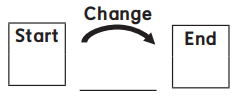
Answer:
Number of home runs Kendra hit in all = 5 or Five.
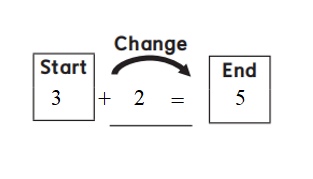
Explanation:
Number of home runs Kendra hit at her first softball game = 3 or Three.
Number of home runs Kendra hit at her next game = 2 or Two.
Number of home runs Kendra hit in all = Number of home runs Kendra hit at her first softball game + Number of home runs Kendra hit at her next game
= 3 + 2
= 5 or Five.
Question 2.
David told 4 jokes yesterday. He told 5 more jokes today. How many jokes has David told in all?
__________ jokes
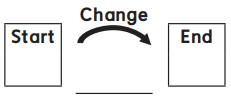
Answer:
Total number of jokes David told in all = 9 or Nine.
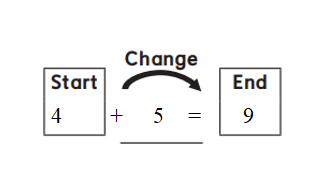
Explanation:
Number of jokes David told yesterday = 4
Number of more jokes David told today = 5
Total number of jokes David told in all = Number of jokes David told yesterday + Number of more jokes David told today
= 4 + 5
= 9 or Nine.
Practice
Question 3.
Count by 1s.
17, 18, 19, _______, _______, _______, _______, _______
Answer:
17, 18, 19, ___20____, __21_____, ___22____, ____23___, ___24____ .
Explanation:
Count by 1s:
17 , 18 , 19 , 20 , 21 , 22 , 23 , 24 .
Everyday Mathematics Grade 1 Home Link 2.9 Answers
Change-to-Less Number Stories
Family Note
Today your child continued exploring real-life number stories. Children learned about change-to-less number stories, in which things are taken away from starting quantities. Work with your child to make sure he or she can identify the information needed to complete the change diagrams below.
Complete the change diagrams to solve the number stories.
Question 1.
Erin had 8 balloons. 3 balloons popped. How many balloons does Erin have left?

_________ balloons
Answer:
Number of balloons Erin had left = 5 or Five.
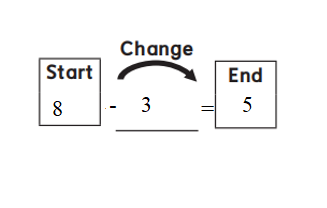
Explanation:
Number of balloons Erin had = 8 or Eight.
Number of balloons Erin had popped = 3 or Three.
Number of balloons Erin had left = Number of balloons Erin had – Number of balloons Erin had popped
= 8 – 3
= 5 or Five.
Question 2.
Kesha had 10 books. She read 7 of the books. How many books does Kesha have left to read?

_________ books
Answer:
Number of books Kesha had left to read = 3 or Three.

Explanation:
Number of books Kesha had = 10 or Ten.
Number of books Kesha had read = 7 or Seven.
Number of books Kesha had left to read = Number of books Kesha had – Number of books Kesha had read
= 10 – 7
= 3 or Three.
Practice
How many tally marks?
Question 3.
![]() ________ tally marks
________ tally marks
Answer:
Number of Tally marks = 11 or Eleven.
Explanation:

Number of Tally marks = 5 + 5 + 1 = 10 + 1 = 11 or Eleven.
Question 4.
![]() ________ tally marks
________ tally marks
Answer:
Number of Tally marks = 15 or Fifteen.
Explanation:

Number of Tally marks = 5 + 5 +5 = 10 + 5 = 15 or Fifteen.
Question 5.
![]() ________ tally marks
________ tally marks
Answer:
Number of Tally marks = 4 or Four.
Explanation:

Number of Tally marks = 4 or Four.
Everyday Math Grade 1 Home Link 2.10 Answer Key
Number Models
Family Note
In the last two lessons, children worked with change-to-more and change-to-less situations using change diagrams. Today they wrote number models using numbers and mathematical symbols (+, –, =) to represent these number stories. Do not worry if your child still needs help writing number models. There will be many opportunities for your child to practice this throughout the year.
Write a number model for each number story. Use the change diagrams to help you.
Question 1.
Rebecca read 4 books last week. She read 4 more books this week. How many books did Rebecca read in all?

________ + ________ = ________
________ books
Answer:
Number of books Rebecca reads in all = 8 or Eight.
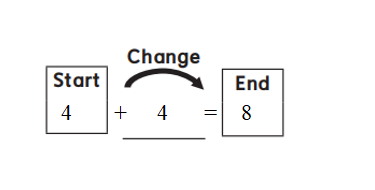
Explanation:
Number of books Rebecca reads last week = 4 or Four.
Number of books Rebecca reads this week = 4 or Four.
Number of books Rebecca reads in all = Number of books Rebecca reads last week + Number of books Rebecca reads this week
= 4 + 4
= 8 or Eight.
Question 2.
The zoo had 9 lions. 3 lions moved to another zoo. How many lions were left?
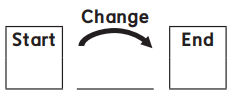
________ – ________ = ________
________ lions
Answer:
Number of lions left in the Zoo = 6 or Six.
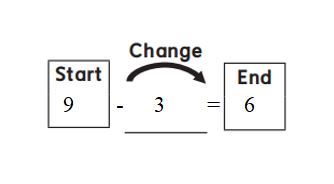
Explanation:
Number of lions Zoo had = 9 or Nine.
Number of lions moved to another zoo = 3 or Three.
Number of lions left in the Zoo = Number of lions Zoo had – Number of lions moved to another zoo
= 9 – 3
= 6 or Six.
Practice
Question 3.
Count the windows in your home. Use tallies to show how many windows you have.
_________ windows
Answer:
Total number of Windows in my home = 6 or Six or ![]()
Explanation:
Number of Windows in Hall room in my home = 1 or One.
Number of Windows in Kitchen room in my home = 2 or Two.
Number of Windows in Bath room in my home = 1 or One.
Number of Windows in Bed room in my home = 2 or Two.
Total number of Windows in my home = Number of Windows in Hall room in my home+ Number of Windows in Kitchen room in my home+ Number of Windows in Bath room in my home+ Number of Windows in Bed room in my home
= 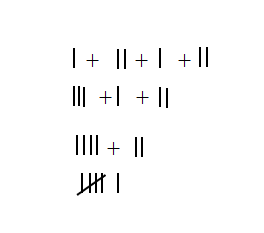
Everyday Mathematics Grade 1 Home Link 2.11 Answers
Finding Unknowns
Family Note
Today your child wrote number models to represent number stories in which various pieces of information were missing or unknown. Children used an empty box like this ☐ to show which part was unknown. Once they solved the number story, they filled in the box with the correct answer. This skill will be further explored and practiced many times throughout the year.
Question 1.
Write a number model to describe the number story. Then solve the problem.

Clint read 5 of his books. He has 3 more books to read. How many books will Clint read in all?
Number model: _________
_________ books
Answer:
Number of books Clint have to read in all = 2 or Two.
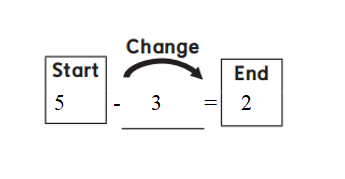
Explanation:
Number of books Clint reads = 5 or five.
Number of books Clint reads more = 3 or Three.
Number of books Clint have to read in all = Number of books Clint reads – Number of books Clint reads more
= 5 – 3
= 2 or Two.
Question 2.
Write a number story for this equation.

Answer:
Number of biscuits Ram ate = 4 or Four.
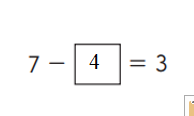
Explanation:
Number of biscuits Ram has = 7 or Seven.
Number of biscuits left out with him at the end = 3 or Three.
Number of biscuits Ram ate = Number of biscuits Ram has – Number of biscuits left out with him at the end =
= 7 – 3
= 4 or Four.
Practice
Question 3.
Write a pair of numbers that add to 10. Use the turn-around rule to write another pair.
Answer:
Numbers paired to add to 10 = 4 (Four) and 6 (Six).
Explanation:
Numbers paired to add to 10 = 4 (Four) and 6 (Six).
=> 4 + 6
=> 10.
Numbers paired to write another pair add to 10 = 6 (Six) and 4 (Four)
=> 6 + 4
=> 10.